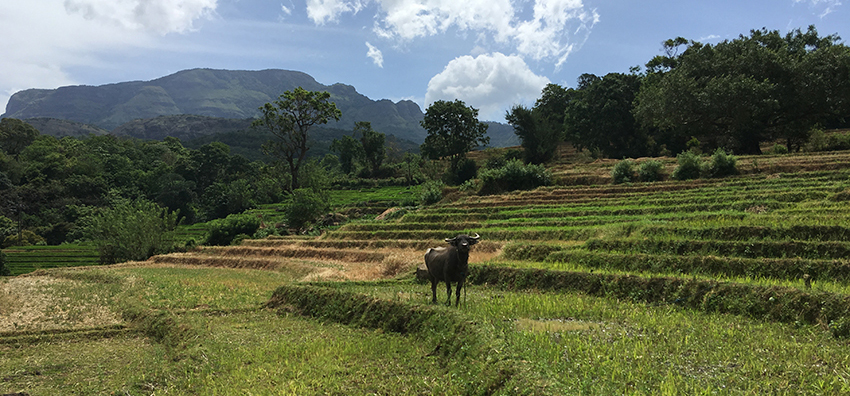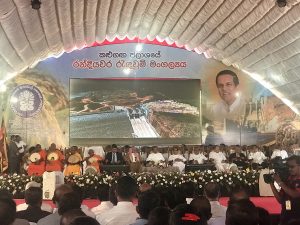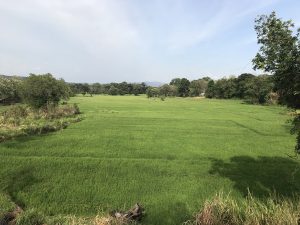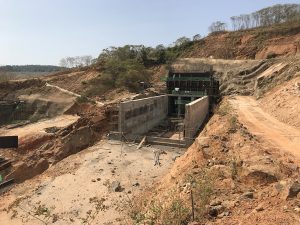In the last month, I attended two ground-breaking ceremonies where the President of Sri Lanka, His Excellency Maithripala Sirisena, launched the construction of two major irrigation projects (the Kaluganga-Moragahakanda Transfer Canal and the North West Province Canal Project). In his remarks in front of crowds of 20,000 people, he said the implementation of the Moragahakanda-Kaluganga Irrigation Development Project is not only a fulfilment of a long awaited aspiration of the farmers, but also a personal dream come true for him.
These projects build on 2 000 years of irrigation development in Sri Lanka. They are key to maintain its continued prosperity. In this post, I share about some of my experiences as a project manager since my work began there in 2014.
The Mahaweli Water Security Investment Program
The Mahaweli Development Program (MDP) was started in the 1970s as the largest multi-use water resources development project in the country’s history. Besides the development of 810 MW of hydropower and construction of irrigation schemes covering 160,000 hectares, the ultimate goal was to transfer excess water from the Mahaweli Basin to the drier north and north-west parts of the island. The country’s civil war disrupted construction of the multi-billion euro project for almost two decades.
The Mahaweli Water Security Investment Program (MWSIP) is the final stage of the MDP, which has been pivotal in meeting national development goals. The investment program will implement major physical investments to address water scarcity, food security, and poverty issues for 6 million people by increasing access to water for irrigation and drinking water. Irrigation water conveyed by the new infrastructure will supply cultivated lands under existing major and minor irrigation schemes. This will increase annual cropping intensities and minimize drought risk.
Our winning bid
I first got involved with the MWSIP in 2014 when the Asian Development Bank (ADB) recruited me as a team leader for the project preparation phase. For several years prior to this, the government had been developing feasibility studies to complete the final stages of the MDP, including some done with Lahmeyer. Before I joined Lahmeyer, our company had already been active in the country for the preparation of the tender designs of the Kaluganga Dam, which has now been constructed. And even before that, we were consultant for preparation of the Electricity Master Plan. Lahmeyer has a long successful history in Sri Lanka since the 1980s.
During the MWSIP project preparation phase (2014-15), our team carried out due diligence on behalf of the government and ADB. For two years we prepared all the necessary financial, economic, procurement, social, environment and climate change assessments following the Bank’s standard requirements. The loan was approved by ADB in 2015.
Subsequently, Lahmeyer International was one of over 30 international engineering companies that applied for the shortlist as the Program Management, Design and Supervision (PMDSC) for the MWSIP. We prepared the winning proposal and signed a contract for over EUR 20 million with the Ministry for Mahaweli Development and Environment. This has included preparing bidding documents for 18 construction packages ranging from EUR 2 million to EUR 300 million.
Irrigation in Sri Lanka – Five years for me, 2000 years for the country
As the Project Director, it has been especially satisfying for me to be involved with the project since the beginning. After five years, I am still working with some of the same Sri Lankan colleagues. I have learned a great deal from them about how to integrate local perspectives into engineering and construction.
Irrigation has been ongoing in Sri Lanka for thousands of years. The early kings started building some of the world’s oldest artificial storage reservoirs in 300 BCE. Local communities built many small cascade systems with reservoirs to supply their paddy fields. Fast forward to today and the country has benefited greatly from its continuous irrigation development and expansion. Sri Lanka is now a middle-income country; and it aspires to become a leading technology and business hub for South Asia.
Changing Sri Lanka for the better
I have witnessed incredible change in Sri Lanka. When the civil war was going on, the capital of Colombo was full of military check-points. Bombings occurred regularly. Now, the situation is quite different: after peace was declared in 2009, it can be difficult to find a hotel since so many tourists arriving from around the world every day.
And we are contributing to this positive development: With our team of almost 100 engineers and diverse consultants we are helping the government to implement what will become one of the world’s largest water resource development projects.
About the irrigation projectsThe Upper Elahera Canal Project has two components:
The North Western Province Canal Project involves building 96 kilometers of new and upgraded canals. This includes a 940 meter tunnel and two new 25 meter tall earth gravity dams, impounding the new Mahakithula and Mahakirula reservoirs. It will transfer water from the Dambulu Oya River and the existing Nalanda and Wemedilla reservoirs to control existing irrigation and water reservoirs. Estimated cost is USD 150 million. |




